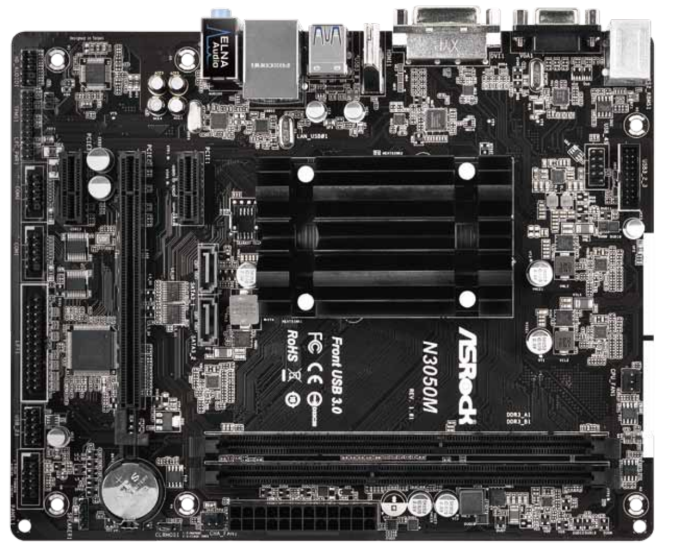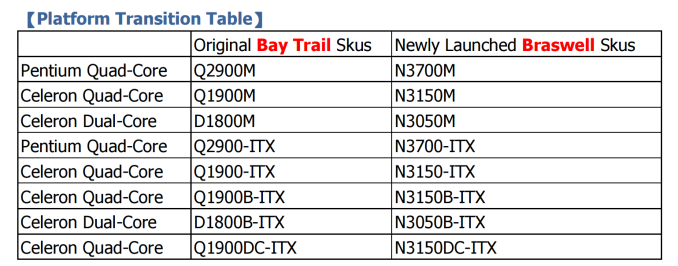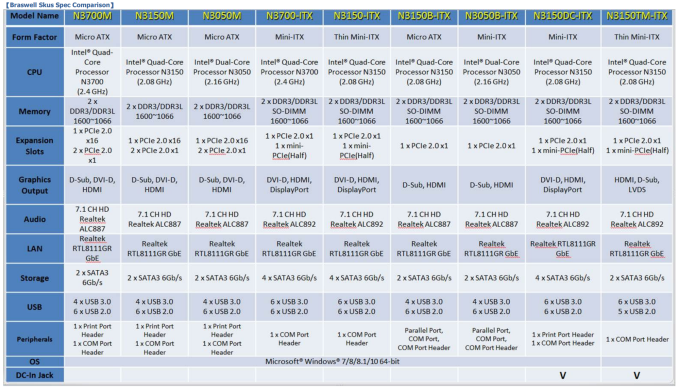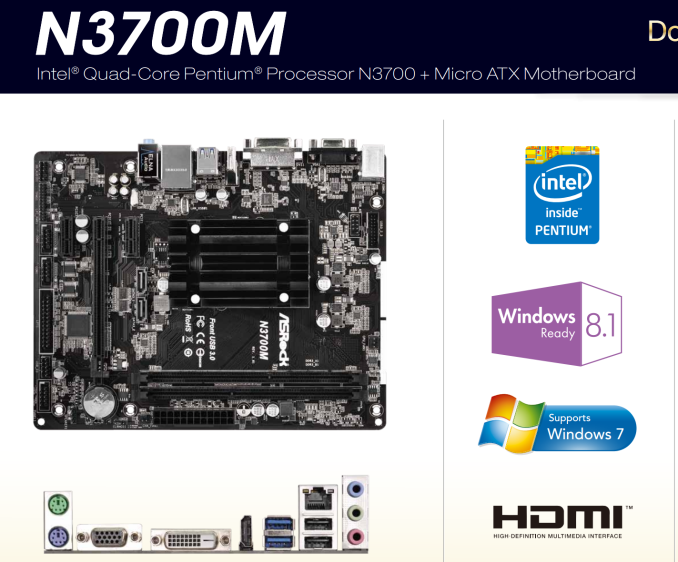ASRock Goes Braswell: Eight SKUs including DC-In Variants
by Ian Cutress on May 19, 2015 9:56 PM EST- Posted in
- Motherboards
- ASRock
- Airmont
- Braswell

In the wake of the news regarding ASUS’ listing of their Braswell motherboards, both ASRock and MSI have been quick on their heels to also list their model lines. ASRock contacted us directly, stating that they will have eight boards on offer in total, although markets for each will vary. They will also transition directly from the Bay Trail-D line, allowing for a quick drop in where required:
Where Bay Trail’s three SoCs, the D1800, Q1900 and Q2900, come into play will be a direct lift into Braswell with the N3050 taking the D1800, the N3150 taking the Q1900 and the N3700 for the Q2900. Personally I preferred the D/Q naming.
For a direct SKU-to-SKU comparison, the N3xx0M boards are microATX, featuring full length DDR3 and a full sized PCIe 2.0 x16 slot (although it will be limited in bandwidth to x1 due to the SoC). The audio codecs between the boards are split with the ALC887 on some and the ALC892 on others, although it is Realtek RTL8111GR across the board for network connectivity. Similarly all boards have SATA 6 Gbps, but some will have two and others will have four. The two SKUs at the end (N3150DC-ITX and N3150TM-ITX) are also capable of being powered by a 19V DC-In on the rear panel, with the final one also supporting LVDS.
What is interesting about the Braswell system list here is the issue surrounding soldered down processors. Rather than have one micro-ATX motherboard and put in the processor you need, we get three different motherboards (N3700M, N3150M and N3050M) that look identical down to the traces on the board but can perform differently. It means that should any of the big CPU players decide to have a non-socketed architecture (remember rumors surrounding Broadwell?) then we would end up with a lot more motherboards on the shelf that look exactly the same, except the processor under the hood.
We’ve asked for a set of the micro-ATX sized boards (and a Q2900) to see how Braswell performs compared to our previous Bay Trail testing. Also, because I feel like sticking in a $70 to $570 discrete graphics cards into one of these and see just how far CPU scaling can go.
Launches of these motherboards will be region dependent, although I have heard from other companies that Braswell isn’t necessary going to be a big launch, and potentially small volume due to the mini-PC space which is consuming more of the point-of-sale types of systems that desktop Atom used to have.
Source: ASRock













19 Comments
View All Comments
nathanddrews - Tuesday, May 19, 2015 - link
"Also, because I feel like sticking in a $70 to $570 discrete graphics cards into one of these and see just how far CPU scaling can go."LOL can't wait!
ImSpartacus - Wednesday, May 20, 2015 - link
I know, right?I'm honestly looking forward to that as well.
frenchy_2001 - Wednesday, May 20, 2015 - link
Biggest bottleneck will probably be the 1x PCIe Gen2 interface.Interface scaling is little till 4x Gen3, but below that, performances take a huge hit.
http://www.techpowerup.com/reviews/AMD/HD_5870_PCI...
http://www.techpowerup.com/reviews/Intel/Ivy_Bridg...
HigherState - Tuesday, May 19, 2015 - link
As far as I can tell, the CPUs only support 4 PCI Express 2.0 lanes. You may have issues trying to get NVIDIA cards to work. Im very interested in using a board like these for HTPC uses, however im thinking I may just get a Shield (Android TV) when it comes out.tspacie - Tuesday, May 19, 2015 - link
NV will work just fine. They used to sell a Quadro NVS x1 and actively optimized for the first generation of Atom CPUs that were also single lane.LukaP - Wednesday, May 20, 2015 - link
There will be no problem. The only problem NV has considering PCIe lanes is their artificial SLI limit to x8 at leastKakti - Tuesday, May 19, 2015 - link
Nice I'm interested in building a super low power htpc/seedbox with one of these braswells.Is the 6x USB 3.0 and 6x USB 2.0 stat correct? Seems high, but if so that's awesome for such a low power cpu/chipset
DanNeely - Wednesday, May 20, 2015 - link
native support is apparently only 4x 3.0, 1x2.0 ports; asrock is apparently using either controller chips or on board hubs. Probably the latter due to a PCIe lane shortage.jimmy$mitty - Wednesday, May 27, 2015 - link
It is a typo on the USB 3.0. ITi only supports 4 USB 3.0, plus there is only one additional header on the top of the board. Per Intels site the chip supports up to 5 USB ports, it doesn't specify how many USB 3.0 or USB 2.0.zodiacfml - Tuesday, May 19, 2015 - link
Can't wait. Let's see how this compares to Core M.